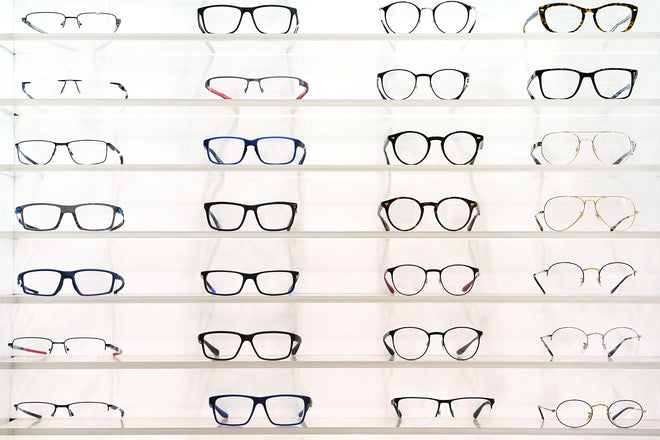Part of my job description as an optometrist is to discuss various options for your eyeglasses. This includes the best frames, types, coatings, and brands that would be right for you.
Today, we will go over which options you might be interested in when you go shopping for your next pair of eyeglasses.
Types of Eyeglasses
In today’s world, eyeglasses have evolved throughout history from a much-needed medical device to a consumable fashion product. Because of this new role, there are many types, colors, shapes, and brands to choose from.
To make an educated decision regarding your next pair of eyeglasses, it’s essential to know more about what you are purchasing and how it meets your needs. That way, you’ll be happy with your decision for years to come.
I’m going to break it down to the types of lenses, coatings, frames, and brands that are most common and discuss why they may be right for you.
Types of Eyeglasses Lenses
Lenses are the part of your glasses you see through, and they come in different materials which have also evolved from glass to various types of plastic.
Glass Lenses
The first eyeglass lenses were made of glass. Glass offers excellent optics and durability—their thickness and composition made them tough. However, the tradeoff was that they were heavy. And despite their durability, they could break if dropped.
Glass lenses were also more expensive to produce than plastic lenses. As a result, the lens industry has gone to plastic as its primary material of choice for making eyeglass lenses.
Publishers comments: The availability of glass lenses for reading glasses is quite rare, almost non-existent in today’s marketplace. The occasional inquiry about them is usually based on their reputation for superior scratch resistance. Properly processed glass lenses are very expensive even if you can find a lab that can give you the quality and consistency you want. Now that plastic lenses represent 99% of all lenses sold, the artistry and equipment to process glass are only found in a handful of specialty labs. Because of the safety aspect of improperly processed low-cost glass lenses and their ability to chip or fracture, our recommendation if you find a reading glass with a glass lens is to stay clear.
Plastic Lenses
Plastic was first used for eyeglass lenses in the mid-1940s, and it hasn’t changed since then. A plastic polymer called CR-39 was used because it was cheap, weighed less than half of the glass’s weight, and had excellent optical quality. CR-39 is a common choice for eyeglasses even today, especially when you’re on a budget.
Polycarbonate Lenses
This lens material was developed in the 1970s by the Gentex Corporation. It’s trendy for use in safety glasses, children’s eyewear, and sports due to its high impact resistance and lighter weight compared to CR-39.
High Index Lenses
This lens was developed later than the lenses mentioned above. High Index Lenses fills a niche for people with high eyeglass prescriptions or who just want a thinner, lighter choice when it comes to lenses. But they come with a higher price tag.
Just the Surface
This is just an overview of the general types of lenses you encounter when shopping for eyeglasses. Current technology has produced an additional option of high definition or digital lenses, customized to your visual needs. This is more expensive and considered a premium or top-shelf product.
Types of Eyeglass Coatings
When it comes to eyeglass lens coatings, you have a lot to choose from. Lens coatings can enhance your vision, improve performance, and make your eyeglasses cosmetically appealing.
Here are some choices and why they might be right for you:
Anti-Reflective Coating
Anti-Reflective Coating (aka AR coating or anti-glare coating) is a trendy choice when it comes to relieving your eyes of glare. If you use computers or other digital devices or are sensitive to lights, then this is the coating for you. It also enhances night vision by reducing glare from oncoming headlights and halos from streetlights. AR coating can also make your lenses look better by reducing the glow that comes off the lenses.
Tinted Lenses
Another popular option is tinted lenses. Tinted lenses can also reduce glare, and they are highly customizable. There is a myriad of colors and graduations to choose from. Specific colors can increase contrast, and others can just reduce the amount of light getting through the lens. Or you can select your favorite color to make a fashion statement.
UV Coating
UV coated lenses block the harmful effects of ultraviolet light from damaging your eyes and causing eye diseases like macular degeneration and cataracts. So, it’s essential to ask for this coating to be included in your lens purchase.
Scratch-Resistant Coating
This is another useful coating to put into your favorite eyewear since it helps extend your lenses’ life. Lenses are exposed to environmental factors like dust, dirt, and contaminants that scratch the lenses and make it hard for you to see. Scratch-resistant coatings make the surface of your lenses harder and more durable.
Photochromic Lenses
Photochromic lenses darken with exposure to sunlight and lighten indoors. They are great for people who like having only one pair of eyeglasses to handle the double duty of regular eyeglasses and sunglasses.
Blue Light Filters
Blue light filters are a popular option since extended exposure to blue light can lead to eye strain, blurred vision, and damage to the back of the eye (retina). It is essential to have when you work on a computer or other digital device for long periods.
Anti-Fog Coatings
This coating is a “must-have” these days since everyone must wear a mask. Anti-fog coating prevents condensation from building up and obstructing your vision, which occurs when wearing your mask and eyeglasses together.
All these coatings can solve problems you experience on a day-to-day basis. Whether it is to reduce glare, protect your eye health, or just to match an outfit with the right colored lenses, there’s a coating to fit everyone’s situation.
Types of Eyeglass Frames
Choosing the right frame is largely about personal style and taste. Today’s frame choices vary in size, shape, material, and options. The choices are almost endless, and it all depends on what speaks to you.
Here are some of the more common types you will encounter:
Full Frames
This style of frame fully encircles the lens. It can be manufactured in any material, ranging from metal to plastic and to other materials like wood. Full-rimmed frames are usually the most durable since they fully support the lens and impact resistance.
Semi Frame
Semi-frame glasses offer something in between fully rimmed and rimless frames. It’s lighter than the fully bound version but more durable than the rimless frame.
Rimless Frame
As the name implies, the rimless frame incorporates lenses that are supported by only two contact points on each lens. It’s the most natural and minimalist choice since it doesn’t cover your eyes’ details but the most fragile of the three options.
Infinite Styles
There are so many iterations of all the types above that you can have a different style every day and never run out. Ultimately, it’s trying on the frame itself that will decide if it’s right for you.
Also, when you talk about eyeglass frames, specific shapes have been around for a long time.
So, let’s talk about a few you’ll probably encounter when shopping for your favorite eyewear.
Most Common Types of Eyeglass Frames:
The following are only a few examples of the frame shapes you can indulge in when shopping for your next pair of eyeglasses, however, the best way to find a style that works for you is to try on a few different pairs to see which ones work best for your face shape and personality.
Round Frames
The original, classic design for eyeglasses that is popular even today. The rounded shape conveys the geeky intellectual style popularized by Harry Potter, John Lennon, and Ozzy Osborne.
Square Frames
If the smart, scholarly look is what you’re after, square frames are right for you. They denote an intellectual, professional look to any wardrobe or fashion.
Oval Frames
A timeless classic to anyone with a serious, mature side, these frames are best for people with delicate features. It is the “in-between” look from the other two mentioned above.
Final thoughts
As you can see, there are many shapes, styles, coatings, and materials to choose from. Since most eyeglass wearers keep their favorite pair for one to three years, it’s essential to take your time and shop around to see which one fits you best.
At ReadingGlasses.com, there are a wide array of eyeglasses to choose from—and friendly staff available to help you choose your new favorite pair of glasses.





